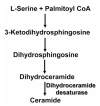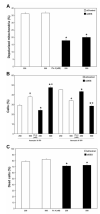Dihydroceramide desaturase knockdown impacts sphingolipids and apoptosis after photodamage in human head and neck squamous carcinoma cells
- PMID: 23267130
- PMCID: PMC3905466
Dihydroceramide desaturase knockdown impacts sphingolipids and apoptosis after photodamage in human head and neck squamous carcinoma cells
Abstract
Background: Dihydroceramide desaturase 1 (DES) is the enzyme responsible for converting dihydroceramide into ceramide in the de novo sphingolipid biosynthesis pathway. Dihydroceramide can inhibit ceramide channel formation to interfere with apoptosis. We have shown that following ceramide synthase knockdown, photodynamic therapy (PDT), a cancer treatment modality, is associated with decreased levels of ceramides and dihydroceramides in cells that are resistant to apoptosis.
Aim: Here we investigated the effect of DES knockdown on the sphingolipid profile and apoptosis in human head and neck squamous carcinoma cells after PDT with the silicon phthalocyanine Pc 4.
Materials and methods: Following siRNA transfection and PDT treatment, quantitative real-time polymerase chain reaction for quantification of DES mRNA, immunoblotting for protein expression, mass spectrometry for sphingolipid analysis, spectrofluorometry for caspase 3-like (DEVDase) activity, flow cytometry for apoptosis detection, and trypan blue assay for cell viability evaluation, were performed.
Results: Down-regulation of DES led to a substantial increase in levels of dihydroceramides without affecting ceramide levels. PDT-induced accumulation of individual dihydroceramides and global ceramides was increased by DES knockdown. Concomitantly, mitochondrial depolarization, DEVDase activation, late-apoptosis and cell death were attenuated by DES knockdown. Early apoptosis, however, was enhanced.
Conclusion: Our findings support the following: (i) dihydroceramide reduces pro-apoptotic effects of ceramide; (ii) cells adapt to DES knockdown to become more sensitive to ceramide and early-apoptosis; (iii) DES is a potential molecular target for regulating apoptotic resistance to PDT.
Figures




Similar articles
-
siRNA-mediated down-regulation of ceramide synthase 1 leads to apoptotic resistance in human head and neck squamous carcinoma cells after photodynamic therapy.Anticancer Res. 2012 Jul;32(7):2479-2485. Anticancer Res. 2012. PMID: 22753704 Free PMC article.
-
Ceramide synthase 6 knockdown suppresses apoptosis after photodynamic therapy in human head and neck squamous carcinoma cells.Anticancer Res. 2012 Mar;32(3):753-60. Anticancer Res. 2012. PMID: 22399588
-
Increased killing of SCCVII squamous cell carcinoma cells after the combination of Pc 4 photodynamic therapy and dasatinib is associated with enhanced caspase-3 activity and ceramide synthase 1 upregulation.Int J Oncol. 2013 Dec;43(6):2064-72. doi: 10.3892/ijo.2013.2132. Epub 2013 Oct 9. Int J Oncol. 2013. PMID: 24126464 Free PMC article.
-
Dihydroceramide desaturase 1, the gatekeeper of ceramide induced lipotoxicity.Biochim Biophys Acta. 2015 Jan;1851(1):40-50. doi: 10.1016/j.bbalip.2014.09.021. Epub 2014 Oct 2. Biochim Biophys Acta. 2015. PMID: 25283058 Review.
-
Dihydroceramide desaturase and dihydrosphingolipids: debutant players in the sphingolipid arena.Prog Lipid Res. 2012 Apr;51(2):82-94. doi: 10.1016/j.plipres.2011.12.002. Epub 2011 Dec 17. Prog Lipid Res. 2012. PMID: 22200621 Review.
Cited by
-
Sphingolipids in Atherosclerosis: Chimeras in Structure and Function.Int J Mol Sci. 2022 Oct 8;23(19):11948. doi: 10.3390/ijms231911948. Int J Mol Sci. 2022. PMID: 36233252 Free PMC article. Review.
-
Native and Polyubiquitinated Forms of Dihydroceramide Desaturase Are Differentially Linked to Human Embryonic Kidney Cell Survival.Mol Cell Biol. 2018 Nov 13;38(23):e00222-18. doi: 10.1128/MCB.00222-18. Print 2018 Dec 1. Mol Cell Biol. 2018. PMID: 30224516 Free PMC article.
-
Bioactive sphingolipid profile in a xenograft mouse model of head and neck squamous cell carcinoma.PLoS One. 2019 Apr 19;14(4):e0215770. doi: 10.1371/journal.pone.0215770. eCollection 2019. PLoS One. 2019. PMID: 31002723 Free PMC article.
-
Dihydroceramides: From Bit Players to Lead Actors.J Biol Chem. 2015 Jun 19;290(25):15371-15379. doi: 10.1074/jbc.R115.653204. Epub 2015 May 6. J Biol Chem. 2015. PMID: 25947377 Free PMC article. Review.
-
The Cross-Talk Between Sphingolipids and Insulin-Like Growth Factor Signaling: Significance for Aging and Neurodegeneration.Mol Neurobiol. 2019 May;56(5):3501-3521. doi: 10.1007/s12035-018-1286-3. Epub 2018 Aug 23. Mol Neurobiol. 2019. PMID: 30140974 Free PMC article. Review.
References
-
- Fabrias G, Munoz-Olaya J, Cingolani F, Signorelli P, Casas J, Gagliostro V, Ghidoni R. Dihydroceramide desaturase and dihydrosphingolipids: Debutant players in the sphingolipid arena. Prog Lipid Res. 2012;51:82–94. - PubMed
-
- Zheng W, Kollmeyer J, Symolon H, Momin A, Munter E, Wang E, Kelly S, Allegood JC, Liu Y, Peng Q, Ramaraju H, Sullards MC, Cabot M, Merrill AH., Jr. Ceramides and other bioactive sphingolipid backbones in health and disease: Lipidomic analysis, metabolism and roles in membrane structure, dynamics, signaling and autophagy. Biochim Biophys Acta. 2006;1758:1864–1884. - PubMed
-
- Stiban J, Fistere D, Colombini M. Dihydroceramide hinders ceramide channel formation: Implications on apoptosis. Apoptosis. 2006;11:773–780. - PubMed
Publication types
MeSH terms
Substances
Grants and funding
LinkOut - more resources
Full Text Sources
Medical
Research Materials
